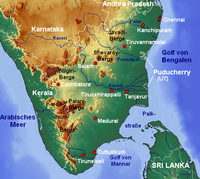
Photo from wikipedia
Coastal areas commonly consist of an environment of intense economic uses and are thus exposed to conflicts between anthropogenic activities and biodiversity. While several approaches of nature protection have been… Click to show full abstract
Coastal areas commonly consist of an environment of intense economic uses and are thus exposed to conflicts between anthropogenic activities and biodiversity. While several approaches of nature protection have been applied to the terrestrial domain, aquatic biotopes frequently still lack a good ecological state as required by EU policies (WFD and MSFD). For numerous years, the underwater world has been considered as one sphere and was neglected in the development of distinctive concepts of conservation for its variety of biotopes. This paper’s objective is the enhancement of ecological connectivity within the study area through the design of benthic wildlife corridors and a consequent sublittoral biotope network. A step-by-step approach is presented for the optimization of ecological potential in heavily modified coastal water bodies, using Kiel Fjord (Western Baltic Sea) as a case study. The procedure for the development of wildlife corridors includes defining and mapping of existing biotope types, the identification of key species for each biotope type and delineating their mobility range, the reconstruction of near-natural / pre-industrial conditions and deriving the protection priorities by comparing past with current / modified conditions. By harmonizing these scientific insights with the local land use of human society, proposals for biotope restoration and improvements can be made. In Kiel Fjord, compensation measures, obligatory for human interventions, such as construction work in the marine environment in this case, have been implemented and present an opportunity to enhance the connectivity of biotopes, thus creating wildlife corridors for their inhabitants. The composition of benthic wildlife corridors, forming a sublittoral biotope network in accordance with the present anthropogenic uses, holds potential for implementation in comparably altered coastal water bodies and integration into national and international frameworks, in anticipation of its functionality.
Journal Title: Journal of Coastal Conservation
Year Published: 2017
Link to full text (if available)
Share on Social Media: Sign Up to like & get
recommendations!